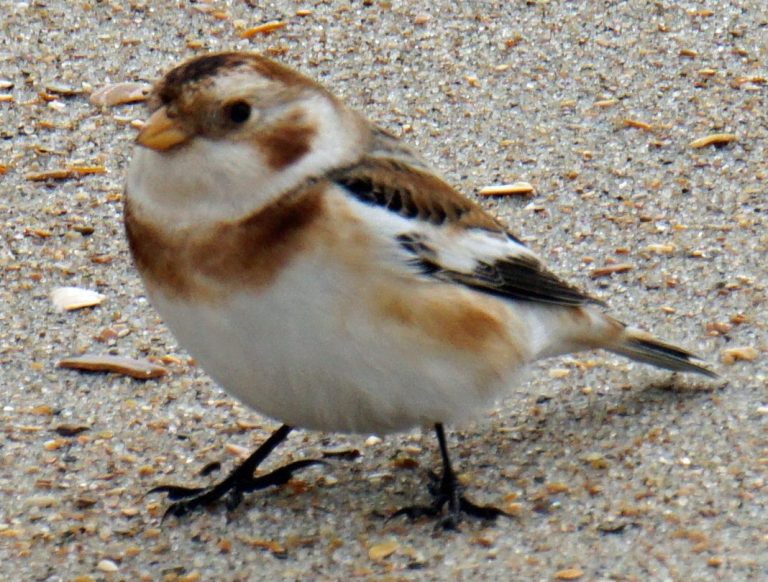
Reprinted from the Ocracoke Observer
Birds are amazing in that they may be found in the most extreme habitats.
Supporter Spotlight
One of these is the snow bunting (Plectrophenax nivalis). They have the distinction of being the most northerly passerine bird in the world, breeding on the rocky tundra in the utmost levels of the circumpolar arctic.
Migratory birds, the males, from “balmy” areas such as southern Quebec, return north in April when the weather is still freezing and snow present. Females wait four to six weeks before venturing to their nesting grounds.
Speculation as to why the males arrive so early is that they compete to secure a nesting site amidst a limited number of crevices in the rocks that will be safe from predators and near vegetated tundra for feeding.
Because the rocks are cold, the female will line the nest with moss, fur and feathers to help keep the eggs and nestlings warm. The female must remain on the nest for most of the incubation period while the male feeds her. They also nest in artificial sites including buildings, barrels, cans and stone foundations.
Their winter habitat includes open weedy, grassy and plowed fields, grain stubbles, roadsides and farm yards. They can also be found on shores, beaches and dunes.
Supporter Spotlight
In the East, they sometimes can be seen in mixed flocks with horned larks and Lapland longspurs.
They are most likely to be seen on the upper Outer Banks from late October into March. Although not unusual to be seen on Pea and Hatteras islands, they are rare on Ocracoke, Portsmouth and points below. Ocracoke’s high school math teacher, Beth Layton, discovered this bunting on a late afternoon walk last winter.
Predators that will kill the birds or take the eggs in these remote parts of the world include gyrfalcons, peregrine falcons, long-tailed jaegers, snowy owls, short-tailed weasels and Arctic foxes. Its most dangerous foe, however, is adverse weather that can lead to freezing and starvation.
The female usually lays four to seven eggs starting in mid-June and incubation is only about 10 days. Both parents feed the nestlings, which fledge within about two weeks.
During breeding season, males are white with a black back, wingtips and bill. The female has the same coloration pattern but is reddish-brown instead of black.
In flight, the clear contrast between the white and black of the wings is evident. The female resembles the male, but has a grey-brown head and back. Both sexes have a black bill and legs. In winter plumage, the male has brownish upper-parts that have black streaks. The crown, sides of the head and the breast have a yellow-brown tinge. The female in winter plumage is more buff than in summer. The bill of both sexes is yellow during winter.
The song has been described as short, but musical, bold and loud for size and with fair variety of phrasing. Typical version might be rendered “turee-turee-tureet-turiwee.”
These are ground birds, sometimes seen individually but often in flocks of up to 100 or more. Their primary food source is seeds of grass and weeds. During breeding season, they will also feed on invertebrates.
Snow buntings were hunted in the past for food. A New York Times article in 1903 noted a person on trial in violation of a state law for possession of 30,000 dead birds harvested in Canada.
Because of their remote breeding range in the high arctic and their nomadic habits during winter, they have not been closely studied.
Best time to see: Unusual but possibly mid-fall through winter
Where: Beach and dunes, pony pasture
A curious note about this species is that John James Audubon in his “Birds of America,” first published as a series in sections between 1827 and 1838, noted that only a single nest of this bird had been found within the limits of the United States (Alaska was not yet a state).
“It was seen by J. Wright Boott Esq. of Boston, on a declivity of the White Mountains of New Hampshire, in the month of July 1831. That gentleman described it to me as being fixed on the ground amid low bushes, and formed like that of the Song Sparrow. It contained young ones.” Boott was a prominent, though eccentric and troubled, Bostonian who had a passion for plants, especially orchids. He discovered a small previously unknown species of Prenanthes that is now known as Alpine Rattlesnake root, Prenanthes boottii.
This story is provided courtesy of the Ocracoke Observer, a newspaper covering Ocracoke island. Coastal Review Online is partnering with the Ocracoke Observer to provide readers with more environmental and lifestyle stories of interest along our coast.








